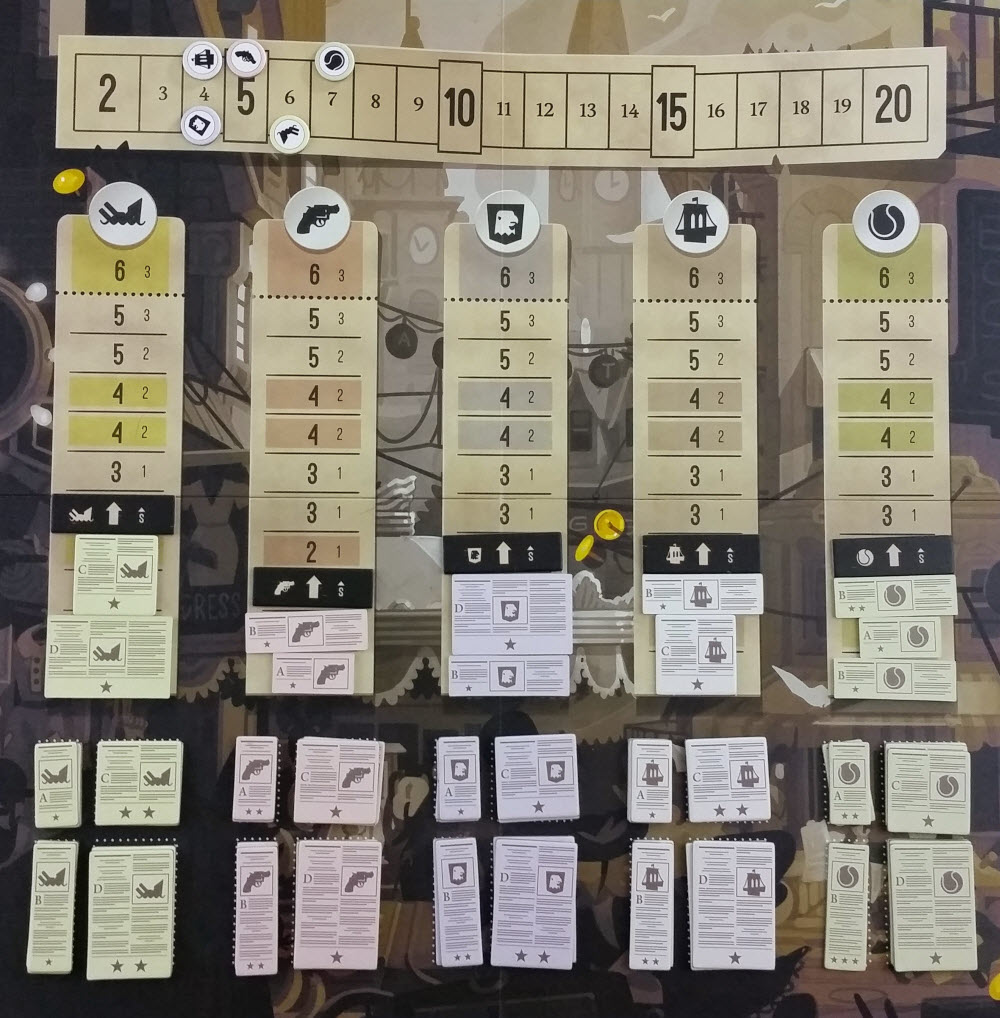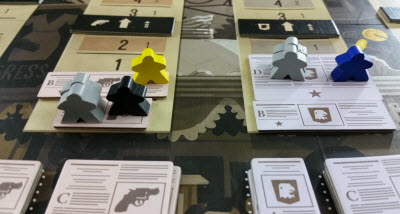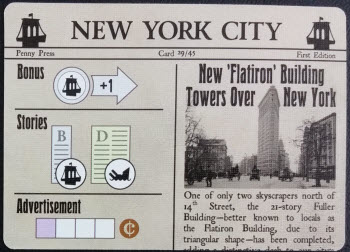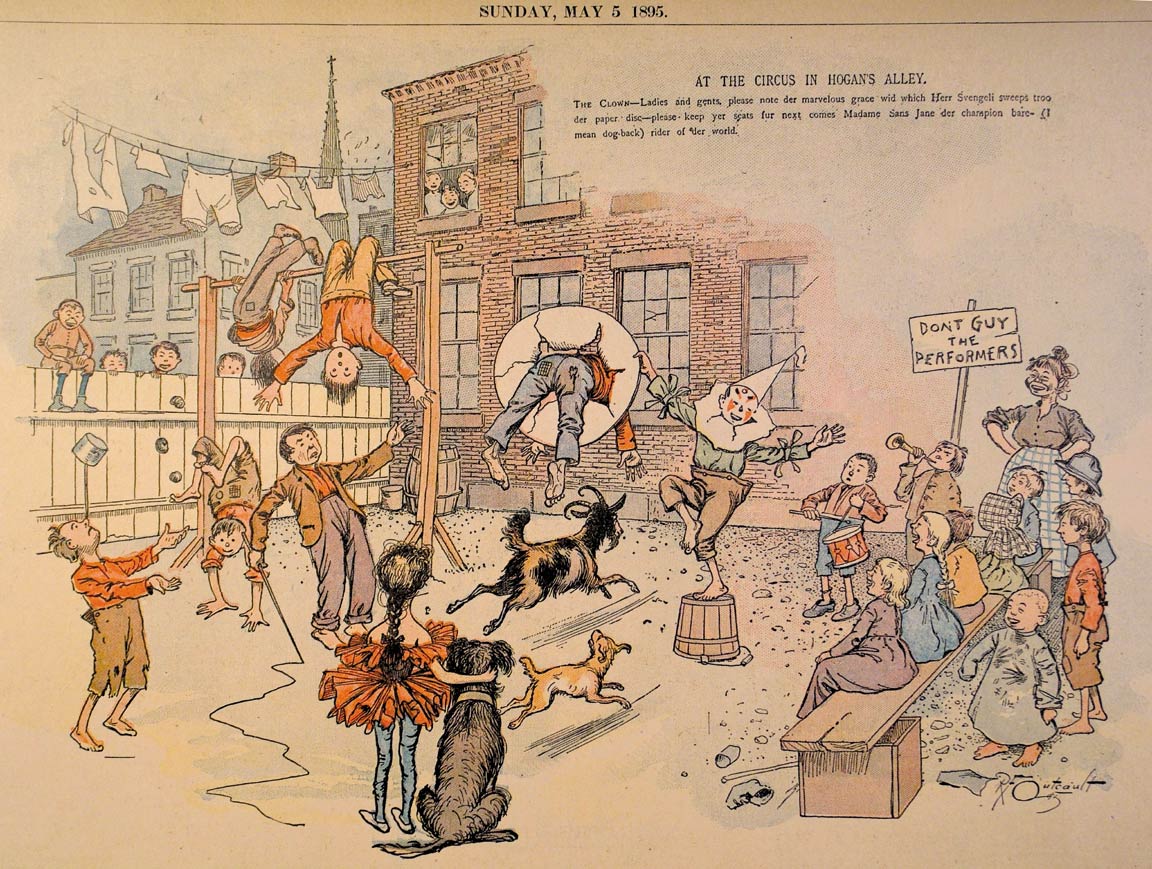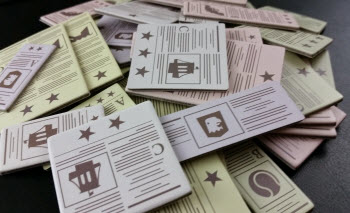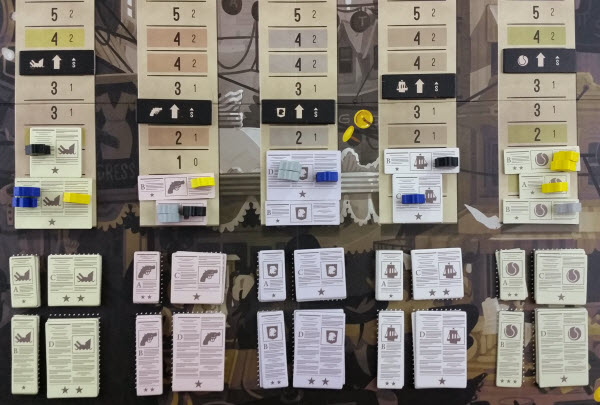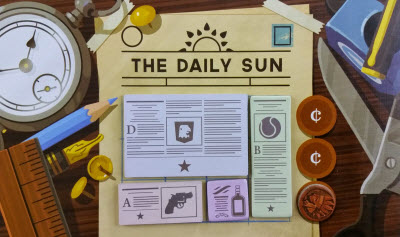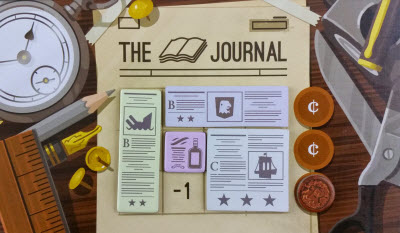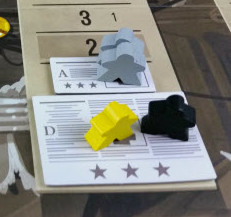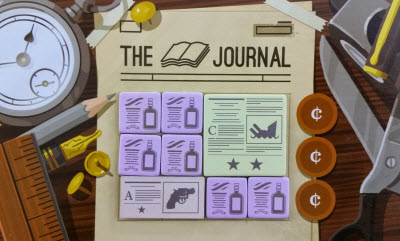“Put it before them briefly so they will read it, clearly so they will appreciate it, picturesquely so they will remember it, and above all, accurately so they will be guided by its light.” – Joseph Pulitzer
The Premise
New York has entered an era of super competitive journalism in the late 1890s. Here, objectivity is nice, but speed and efficacy in reporting the news – especially ahead of your rivals – is paramount. As fledgling editors fighting over a limited number of stories, players in Penny Press deploy their reporters out into the city so that they can scoop up recent news and get them to print before everyone else.
The Rules
Penny Press is a lightweight Worker Placement and spatial reasoning game. To be news ready though, it requires mild setup. The board is laid out in five columns, each devoted to a particular news genre, with four differently-sized tile stacks of that genre stacked below each column. At the start of the game, a Headline Card is drawn for each player, their listed stories added to the board. These are the initial stories currently developing in the city, and they’re fair game for any of the journalists. Headline Cards also state which genres are currently popular among readers. This is tracked along the top of the board, granting bonuses at the end of the game. Once all the stories are placed, an arrow marker, known as a News Beat, is placed above the articles in each column. News Beats tell players the current value of those genre articles when claimed, and they adjust frequently.
Penny Press is played out over a variable number of turns, with the first player being the one who most recently read an actual newspaper. To begin, each player receives a news mat and five journalist meeples.
During their turns, players take one of four possible actions: Assign Reporters, Recall Reporters, Reassign a Reporter, or Go To Print.
When working a story, the player may move one or more meeples onto a news tile from their supply (Assign Reporters) or a single meeple from one story to another (Reassign a Reporter). Alternatively, players can Recall Reporters, pulling one or more back to their supply.
The most important action a player can take is Going to Print, which is, basically, scoring. When a player decides to print, they claim all stories where they are least tied for the most journalists. Any other players on those spaces gain Scoop Points (for having been covering the story also), gaining VP according to the News Beat column’s secondary number. The current player then lays out these stories on their newspaper’s 3×4 grid. The goal is to fit everything with no blank spaces. Empty grid spaces lose points, but stories that can’t fit on the grid lose even more. Players must also place the most valuable stories at the top of the grid.
Once finished, the player scores VP equal to the news stories, then draws a new Headline Card to add new stories to the board. However, after the first print run, players must also contend with placing advertisements on their page, as depicted.
Turns progress until one player has gone to print 3-4 times, depending on player size. At that point, everyone takes one more turn, then has one last chance to Go to Print. Finally, VP from each bonus track is awarded to whoever has the most valuable completed stories of that genre.
The player with the most VP has proven themselves to be the true master of yellow journalism and has secured their literary legacy.
Everyone else will be relegated to doing nothing but boring fluff pieces…forever.
Black And White And Read All Over
The most striking attribute of Penny Press can be observed before the game even begins. Penny Press has a rather unique color scheme to it, jumping wholeheartedly into its turn-of-the-century newspaper theme.
Although newspapers of this era had access to color ink, the array of colors and shades available to them were far more limited than today. Many ink colors took too long to dry or were prohibitively expensive, and so most newspapers – especially those competing for circulation – opted for more readily available options. The results are exemplified in the softer and more limited hues that Penny Press is chock full of, such as orange, yellow, blue-gray, and faded reds and greens.
These color choices were clearly deliberate, and while the game’s overall appearance won’t pop out at you with vibrancy, it does a remarkably salient job reinforcing the setting. From the newspaper clippings to the workers themselves, the game’s more subdued palette deftly encapsulates the feel of the time period. Not only does it work, but it works incredibly well, making it a worker placement game that hits the ideal melding of mechanics and flavor. When combined with the decent quality stock of the game’s tiles and tokens, as well as the fact that Headline Cards reference real stories of the day, Penny Press is precisely the type of light worker placement game that Immersionists can get into. The only detraction from this overall presentation is small: the player news boards are too thin. Although they’re only used when you go to press, they don’t quite line up with the rest of the elements pictured here.
The Daily Grind Versus The Weekly Standard
The entire concept of New York’s yellow journalism circulation wars that’s represented in this game was born out of the incessant desire of multiple newspapers to fiercely fight with each other for readership at any cost. At the heart of that contest, though, lies the age old truth that while competition itself can bring about great things, having too much or too little can actually make things worse. Although assuredly coincidental, this also holds true with Penny Press.
That is, player size in Penny Press has a direct effect on the overall tone of your playthrough. In games of two players, for example, there are very few newspaper tiles to compete over. With less headlines in the field, there’s less necessity for planning, especially when taking into account that two-player mode functions differently by having players double up on taking turns. With both players focusing on a scant few tiles and both (usually) going to press within a turn or two of each other, two-player mode makes for a faster-paced affair that rewards whoever can routinely scoop the other first by snatching mutually-desired stories. With two players, gauging the best moment to claim stories is essential, but it trades the dynamic nature of multiple players jockeying over tiles to get this more competitive feeling. Two player Penny Press is quick and engaging, but it possesses a distinctly different tone than other player sizes.
On the other end of the spectrum lies games with a full five player complement. In these games, the opposite occurs. With a minimum of ten news stories on the board at the start and more people regularly going to press, the desired nature of competing for the same tiles is diluted. Since there are more tiles to go around, there’s less need to clash over promising stories, and as a result, with five players the game tension that otherwise drives Penny Press so well feels more like a midweek lull instead of a Sunday edition.
Ultimately, Penny Press works best with 3-4 players, providing the right mix of tile scarcity and necessity to strategize. Irrespective of player size though, the game remains remarkably accessible. With its shorter than expected gameplay sessions – usually under and hour – and the interactive nature of player’s journalists vying for the same stories, this is one worker placement that even Socializers can enjoy. That fact alone is pretty newsworthy, but it’s especially poignant when taking into account why Strikers also appreciate Penny Press: aside from the information of newly revealed Headline Cards, Penny Press is a fairly low-luck game.
Good Writing Isn’t Easy
Penny Press may be straightforward game about making the news, but it still offers a couple pleasant surprises. Firstly, dealing with advertisements can make going to print deceptively challenging. Initially, going to press is rather easy, as all you do is fill up a solid 3×4 grid.
However, in each of your subsequent press runs you then must contend with a randomly placed advertisement that slowly works its way up the rows. This seemingly simple obstacle constricts not only how you can arrange your articles but which can even be placed on your board. It’s like a copy editor’s version of Tetris.
In turn, this has an immediate bearing on which articles you want (or must) stake a claim to. Timing is key to the game’s strategy, as you must balance maximizing the value of your press run with the availability of stories.
Planning to go to press with an incomplete grid and knowing you will lose a point or two, for instance, may be far more preferable than waiting and having the only tile that you need for certain spot be stolen out from under you by someone heading to the presses first. The relationship between spatial awareness and reading the often-fluctuating board is at heart of this editorial endeavor. Unfortunately for Daredevils though, with small VP margins and indirectly punishing you for going to print too early or too late, there’s little space in the Penny Press newsrooms for their unconventional style.
Similarly, although the bonus track can be a minor and easily overlooked aspect of the game, it’s not wise to ignore it entirely. Penny Press has you mostly working press run to press run, but at the end of the game these bonuses can confer some of the biggest point jumps; watch the trends carefully. There easily can be situations, for example, where it’s better to compete over a Crime story that has little payout at the moment if it’ll significantly help you win the Crime bonus later.
In tightly contested games, winning a couple valuable bonuses can secure the win, either in terms of vaulting you far ahead of your competitors or as a catch-up mechanic if you’ve been scooped a few too many times. Tacticians will certainly appreciate this long view component, though whether that’s enough to sustain their subscription after many playthroughs is tough to determine. Architects on the other hand will enjoy hitting the bricks, as they’ll appreciate the tactile nature of accumulating stories for their press runs and potentially using them towards a larger payoff.
The Takeaway
The story has run and the facts are in: Penny Press delivers! It covers all the right angles in how to make a light but worthwhile worker placement game, offering a quick pace, accessibility, and streamlined rules, while still providing substantive gameplay. What makes Penny Press even more newsworthy, however, is the degree to which it embraces its theme of hard-hitting journalists hunting for any scrap of salable news. Like a well-rounded feature page, Penny Press offers up a clear production for the masses with an impressive blending of flavor and mechanics, and although the game may not be the most visually inspiring, its color scheme nonetheless remains an asset to its presentation. The era of yellow journalism was chock full of problems, but luckily for us, Penny Press provides an alternative that’s far less controversial – and far more entertaining.
Penny Press is a product of Asmadi Games.
Cardboard Republic Snapshot Scoring (Based on scale of 5):
Artwork: 3.5
Rules Clarity: 4
Replay Value: 4
Physical Quality: 4
Overall Score: 4
Photo Credits: Hogan’s Alley by Wikia.

